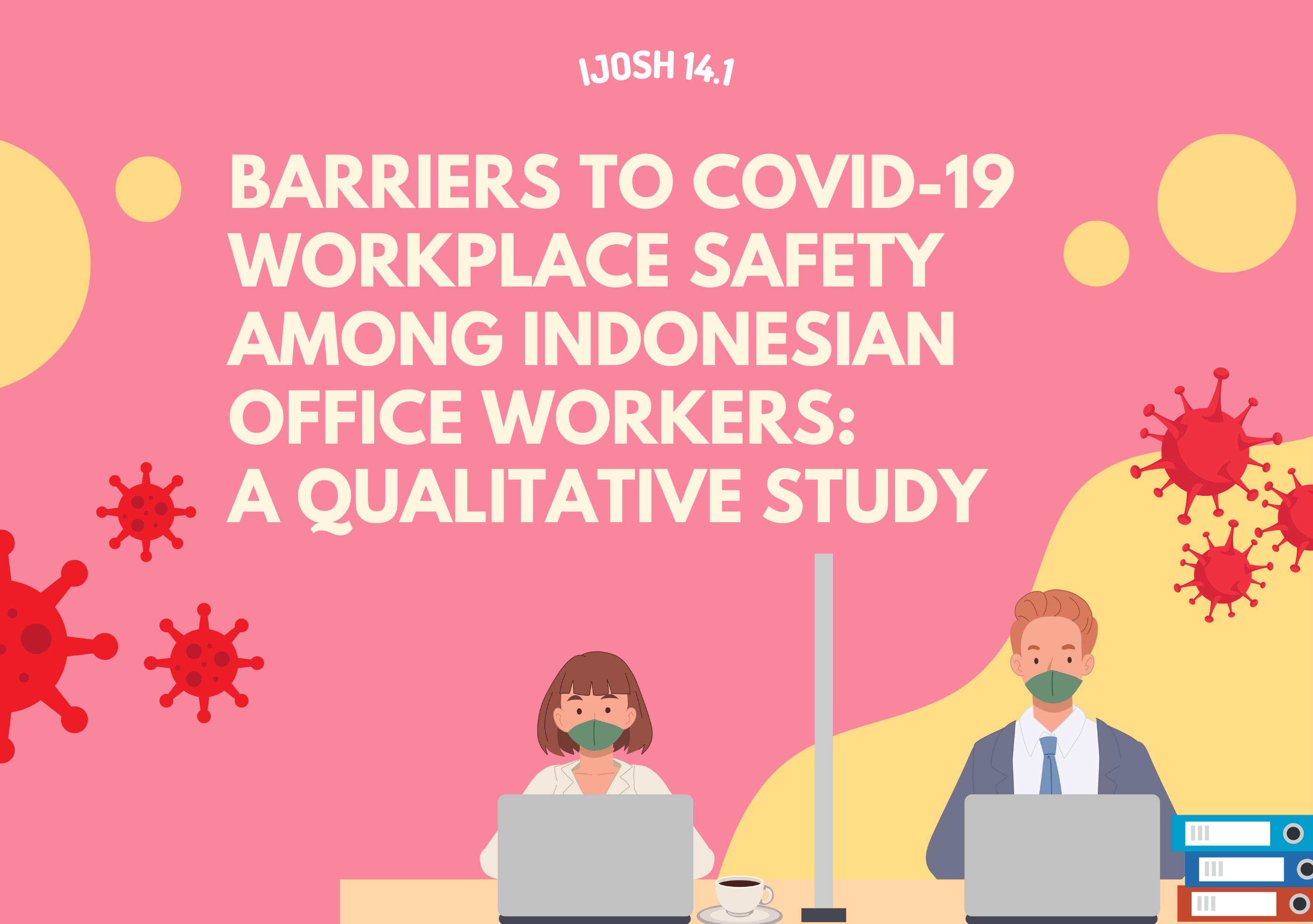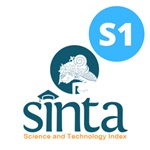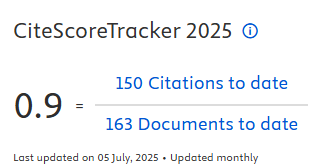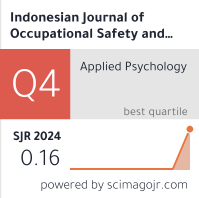Barriers to COVID-19 Workplace Safety among Indonesian Office Workers: A Qualitative Study

Downloads
Introduction: Since the first case of COVID-19 was detected in Indonesia, the government has implemented Large-Scale Social Restrictions to control the spread of the disease. However, these restrictions have had a negative impact on the economy. To address this, the government has introduced a new normal policy to restore activities while managing the risk of transmission. The government has adopted WHO guidelines through Minister of Health Decree No. 238 of 2020 to ensure COVID-19 workplace safety. This article aims to explore the barriers to COVID-19 workplace safety among Indonesian office workers. Methods: This qualitative research was conducted in DKI Jakarta and Surabaya from September to October 2020. In-depth interviews and observations were conducted with 22 informants selected purposefully. Thematic analysis was used, drawing on the Social-ecological Model (SEM) theory. Results: At the intrapersonal level, fear and perception barriers impact preventive actions against COVID-19. At the interpersonal level, peer influence and perceptions of the work environment affect adherence to office policies. At the organizational level, employee behavior is influenced by socializing, rules, and workplace amenities. Lastly, public policy enforcement is vital at the macro level to reduce risky behaviors among office workers. Conclusion: Implementing comprehensive protocols across different levels is crucial to creating COVID-19 workplace safety. This requires increased public awareness and consistent enforcement, including strengthening organizational policies.
Andriyanto, W., Sriatmi, A. and Suryosaputro, A. (2022) ‘Individual and Organizational Factors with Compliance with Infection Prevention and Control Standards in Public Health Center in The COVID-19 Pandemic’, International Journal of Health, Education and Social (IJHES), 5(6).
Anggriawan, R. (2020) ‘Responding to COVID-19: Indonesian Occupational Health and Safety Policy for Corporate Compliance’, Journal of Industrial Hygiene and Occupational Health, 5(1), p. 50. https://doi.org/10.21111/jihoh.v5i1.4669
Boas, H. and Davidovitch, N. (2022) ‘Into the “New Normal”: The Ethical and Analytical Challenge Facing Public Health Post‐COVID‐19’, International Journal of Environmental Research and Public Health, 19(14), pp. 1-12. https://doi.org/10.3390/ijerph19148385
Boulos, D.N.K. and Hassan, A.M. (2023) ‘Using the Health Belief Model to Assess COVID-19 Perceptions and Behaviours among a Group of Egyptian Adults: A Cross-sectional Study’, BMC Public Health, 23(1), pp. 1-11. https://doi.org/10.1186/s12889-023-16513-x
Braun, V. et al. (2019) ‘Thematic analysis’, in Handbook of Research Methods in Health Social Sciences, pp. 843–860. https://doi.org/10.1007/978-981-10-5251-4_103
Charkazi, A. et al. (2021) ‘Association of fear of COVID-19 and preventive behaviors (PB) against COVID-19 in Iran’, Psychiatria, 18(3), pp. 169–175. https://doi.org/10.5603/PSYCH.a2021.0016
Dantjie, P., Setyaningsih, Y. and Nurjazuli (2020) ‘Safety and Health Management Commitment and Implementation of COVID-19 Prevention at Manufacture Workplace Environment’, in E3S Web of Conferences. EDP Sciences. https://doi.org/10.1051/e3sconf/202020212015
DeDonno, M.A. et al. (2022) ‘Perceived Susceptibility and Severity of COVID-19 on Prevention Practices, Early in the Pandemic in the State of Florida’, Journal of Community Health, 47(4), pp. 627–634 https://doi.org/10.1007/s10900-022-01090-8
Djuningsih, R.F. and Samputra, P.L. (2021) ‘The Influence of Risk Perception on Worker Discipline in DKI Jakarta in Implementing the Protocol Covid-19 Health Based on the Health Belief Model Approach’, Jurnal Penelitian Kesehatan Suara Forikes, 12(4), pp. 415-421.
Fadly, F. (2020) ‘“The Effects of Human Mobility Restriction During Covid-19 Pandemic on Indonesia’s Economy”’, Ferdian. Kajian Ekonomi Keuangan, 4(3), pp.263-280. https://doi.org/10.31685/kek.V4.3.678
Fattahi, H., Seproo, F.G. and Fattahi, A. (2022) ‘Effective Factors in People’s Preventive Behaviors during Covid-19 Pandemic: A Systematic Review and meta-synthesis’, BMC Public Health, 22(1), pp. 1-12. https://doi.org/10.1186/s12889-022-13621-y
Fernardo, E. (2021) ‘Experimental Study to Improves Covid-19 Health Protocol Compliance with High Threat and High Efficacy Poster’, Jurnal Komunikasi, 13(2), p. 184. https://doi.org/10.24912/jk.v13i2.11383
Fona, C. (2023) ‘Qualitative data analysis: Using thematic analysis’, in Researching and Analysing Business: Research Methods in Practice, pp. 130–145. https://doi.org/10.4324/9781003107774-11
Hill, L.M. et al. (2022) ‘Barriers to and Facilitators of COVID-19 Prevention Behaviors Among North Carolina Residents’, Health Education and Behavior, 49(2), pp. 231–241. https://doi.org/10.1177/10901981221076408
Hou, H. (Cynthia) et al. (2021) ‘A study on office workplace modification during the COVID-19 pandemic in The Netherlands’, Journal of Corporate Real Estate, 23(3), pp. 186–202. https://doi.org/10.1108/JCRE-10-2020-0051
Houben, F. et al. (2024) ‘Behavioural Determinants Shaping Infection Prevention and Control Behaviour among Healthcare Workers in Dutch General Practices: A Qualitative Study Reflecting on pre-, during and post-COVID-19 Pandemic’, BMC Primary Care, 25(1), pp. 1-13. https://doi.org/10.1186/s12875-024-02304-9
Hu, D. et al. (2021) ‘Factors that Influence Participation in Physical Activity in School-aged Children and Adolescents: A Systematic Review from the Social Ecological Model Perspective’, International Journal of Environmental Research and Public Health, 18(6), pp. 1–22. https://doi.org/10.3390/ijerph18063147
Huynh, N.N.Y. et al. (2020) ‘COVID-19 Clusters at Workplaces and its Transmission into Communities in Vietnam: A Novel Emerging Occupational Risk Factor at Work Due to Coronavirus Infection’, Asian Pacific Journal of Environment and Cancer, 3(1), pp. 27–33. https://doi.org/DOI:10.31557/APJEC.2020.3.1.27.
Indonesia Ministry of Health (2020) Indonesia Ministry of Health.
Indraswari, R., Riani, E.N. and Ambarwati, D. (2021) ‘Employees’ perceptions of COVID-19 transmission prevention at the workplace’, Annals of Tropical Medicine & Public Health, 24(01). https://doi.org/10.36295/asro.2021.24125
Jamaludin, S. et al. (2020) ‘COVID-19 Exit Strategy: Transitioning towards a New Normal’, Annals of Medicine and Surgery, 59, pp.165–170. https://doi.org/10.1016/j.amsu.2020.09.046
Jang, S.H. (2022) ‘Social-ecological Factors related to Preventive Behaviors during the COVID-19 Pandemic in South Korea’, PLoS ONE, 17(3 March). https://doi.org/10.1371/journal.pone.0266264
Jose, R. et al. (2021) ‘Public Perception and Preparedness for the Pandemic COVID 19: A Health Belief Model Approach’, Clinical Epidemiology and Global Health, 9, pp. 41–46. https://doi.org/10.1016/j.cegh.2020.06.009.
Van Kasteren, Y.F., Lewis, L.K. and Maeder, A. (2020) ‘Office-based Physical Activity: Mapping a Social Ecological Model Approach Against COM-B’, BMC Public Health, 20(1). https://doi.org/10.1186/s12889-020-8280-1
Khaday, S., Li, K.W. and Dorloh, H. (2023) ‘Factors Affecting Preventive Behaviors for Safety and Health at Work during the COVID-19 Pandemic among Thai Construction Workers’, Healthcare (Switzerland), 11(3). Available at: https://doi.org/10.3390/healthcare11030426.
Kniffin, K.M. et al. (2020) ‘COVID-19 and the Workplace: Implications, Issues, and Insights for Future Research and Action’, American Psychologist, 76(1), pp. 63–77. https://doi.org/10.1037/amp0000716.
Koerniawan, D. and Frisca, S. (2023) ‘Factors Determining Commitment to Health-Promoting Behavior During COVID-19’, Jurnal Keperawatan Indonesia, 26(2), pp. 97–106. https://doi.org/10.7454/jki.v26i2.1130.
Kurniyati, N., Ma’rufi, I. and Utami, W.S. (2023) ‘The Analysis of Clean and Healthy Living Behavior Factors on Wood Furniture Informal Workers’, Indonesian Journal of Occupational Safety and Health, 12(2), pp. 194–200. https://doi.org/10.20473/ijosh.v12i2.2023.194-200.
Lestari, F. et al. (2022) ‘COVID-19 in the Workplace in Indonesia’, Sustainability (Switzerland), 14(5). https://doi.org/10.3390/su14052745.
Lolita, L. and Ikhsanudin, A. (2022) ‘COVID-19 Risk Perceptions among Healthcare Workers during Early “New Behavior Norms” Phase’, International Journal of Public Health Science, 11(1), pp. 352–358. https://doi.org/10.11591/ijphs.v11i1.21252.
Mezmir, E.A. (2020) ‘Qualitative Data Analysis: An Overview of Data Reduction, Data Display and Interpretation’, Research on Humanities and Social Sciences [Preprint]. https://doi.org/10.7176/rhss/10-21-02.
Muhyiddin (2020) ‘Covid-19, New Normal, and Development Planning in Indonesia’, The Indonesian Journal of Development Planning, 4(2), pp. 240–252. https://doi.org/10.36574/jpp.v4i2.118.
Murti, M. et al. (2021) ‘COVID-19 Workplace Outbreaks by Industry Sector and Their Associated Household Transmission, Ontario, Canada, January to June, 2020’, Journal of occupational and environmental medicine, 63(7), pp. 574–580. https://doi.org/10.1097/JOM.0000000000002201.
Nugraha, B. et al. (2020) ‘COVID-19 Pandemic in Indonesia: Situation and Challenges of Rehabilitation Medicine in Indonesia’, Acta Medica Indonesiana, pp. 299–305. https://www.researchgate.net/publication/344470300.
Nuriati, Y. et al. (2021) ‘Persepsi Karyawan terhadap Ketersediaan Fasilitas dan Sarana Penanganan Covid-19 di Tempat Kerja Berhubungan dengan Kepatuhan Protokol Kesehatan’, Jurnal Kesehatan Masyarakat, 9(4), pp. 566–575. Available at: http://ejournal3.undip.ac.id/index.php/jkm.
Park, S.Y. et al. (2020) ‘Coronavirus disease outbreak in call center, South Korea’, Emerging Infectious Diseases, 26(8), pp. 1666–1670. https://doi.org/10.3201/eid2608.201274.
Republik Indonesia (2020) Republik Indonesia. Indonesia: Kementerian Hukum dan HAM.
Roziqin, A., Mas’udi, S.Y.F. and Sihidi, I.T. (2021) ‘An analysis of Indonesian government policies against COVID-19’, Public Administration and Policy, 24(1), pp. 92–107. https://doi.org/10.1108/PAP-08-2020-0039.
Sari, U.C. and Budiyanti, R.T. (2020) ‘Workplace Requirements in New Normal Era due to COVID-19 Pandemic: Design Criteria and Health Environment Perspectives’, Journal of Public Health for Tropical and Coastal Region, 3(2), pp. 8–14. Available at: http:/ejournal2.undip.ac.id/index.php/jphtr/index.
Scharp, K.M. and Sanders, M.L. (2019) ‘What is a Theme? Teaching Thematic Analysis in Qualitative Communication Research Methods’, Communication Teacher, 33(2), pp. 117–121. https://doi.org/10.1080/17404622.2018.1536794.
Sparrow, R., Dartanto, T. and Hartwig, R. (2020) ‘Indonesia Under the New Normal: Challenges and the Way Ahead’, Bulletin of Indonesian Economic Studies, 56(3), pp. 269–299. https://doi.org/10.1080/00074918.2020.1854079.
Tong, K.K. et al. (2020) ‘Adherence to COVID-19 Precautionary Measures: Applying the Health Belief Model and Generalised Social Beliefs to a Probability Community Sample’, Applied Psychology: Health and Well-Being, 12(4), pp. 1205–1223.: https://doi.org/10.1111/aphw.12230.
Wang, K. et al. (2021) ‘Unequal Availability of Workplace Policy for Prevention of Coronavirus Disease 2019 across Occupations and its Relationship with Personal Protection Behaviours: A Cross-sectional Survey’, International Journal for Equity in Health, 20(1). https://doi.org/10.1186/s12939-021-01527-x.
Whiteman, A. et al. (2020) Morbidity and Mortality Weekly Report Demographic and Social Factors Associated with COVID-19 Vaccination Initiation Among Adults Aged ≥65 Years-United States. Available at: https://www.cdc.gov/vaccines/covid-19/clinical-considerations/.
WHO (2020) COVID-19: Occupational health and safety for health workers: Interim guidance.
Yıldırım, M., Geçer, E. and Akgül, Ö. (2021) ‘The Impacts of Vulnerability, Perceived Risk, and Fear on Preventive Behaviours Against COVID-19’, Psychology, Health and Medicine, 26(1), pp. 35–43. https://doi.org/10.1080/13548506.2020.1776891.

This work is licensed under a Creative Commons Attribution-NonCommercial-ShareAlike 4.0 International License.

In order to be accepted and published by The Indonesian Journal of Occupational Safety and Health, Author(s) who submit an article should complete all the review process. The copyright of received articles assigned to the The Indonesian Journal of Occupational Safety and Health and Department of Safety and Health, Universitas Airlangga as publishers of the journal. The intended copyright includes the rights to publish articles in various forms (including reprints).
The Editorial Team of The Indonesian Journal Of Occupational Safety and Health and Department of Safety and Health strive to ensure that no errors occur in the articles that have been published, both data errors and statements in the article.
Users of this website will be licensed to use materials from this website following the Creative Commons Attribution-NonCommercial-ShareAlike 4.0 International License. No fees charged. Please use the materials accordingly.
------------------------------------------------------------------------------------------------------------------------------------------------------------------------------------------
Attribution ” You must give appropriate credit, provide a link to the license, and indicate if changes were made. You may do so in any reasonable manner, but not in any way that suggests the licensor endorses you or your use.
NonCommercial ” You may not use the material for commercial purposes.
ShareAlike ” If you remix, transform, or build upon the material, you must distribute your contributions under the same license as the original.







 How to Submit Articles in OJS
How to Submit Articles in OJS

























